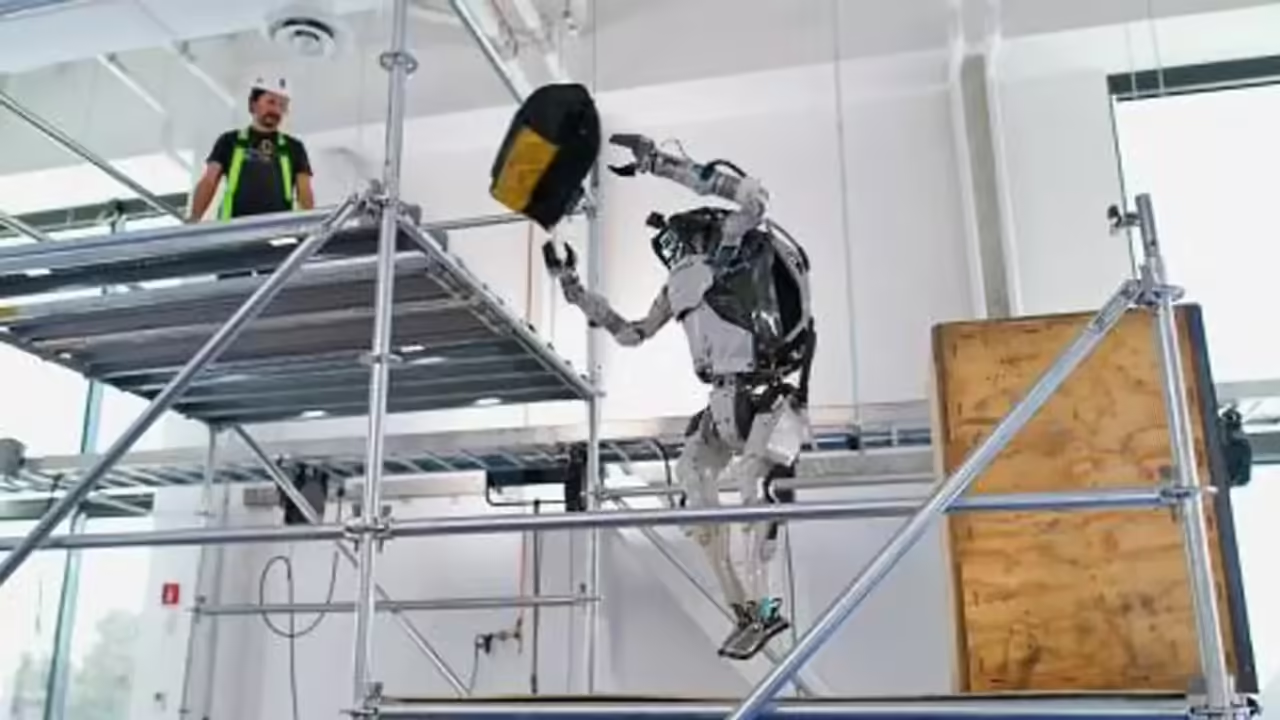
Over the past few decades, automation and robotics have been gaining ground in industry, and more and more human workers are being replaced by machines in factories and other areas of production. This phenomenon has raised many questions and concerns about the future of human labor and the economy in general. Are we witnessing the end of human labor as we know it? Will robots be the new workers of the future?
First, it is important to recognize that automation and robotics have been an integral part of industry for decades. Robots have been used to perform repetitive and dangerous tasks in automotive manufacturing, electronics, food, pharmaceuticals and many other industrial sectors.
In recent years, however, the development of artificial intelligence, machine learning and collaborative robotics has led to the creation of more advanced and flexible robots that can perform a wide variety of tasks, from welding to product assembly and sorting.
As robots become more efficient and cost-effective, employers are understandably looking to automate more processes and reduce labor costs. But this has led to a decline in demand for human workers in many sectors, especially those requiring repetitive and precise manual tasks. According to a World Economic Forum study, by 2025, robots and automation are expected to eliminate 85 million jobs worldwide, although 97 million new jobs will also be created.
This trend towards industrial automation poses a number of economic and social challenges. First, job elimination could increase unemployment and economic inequality, especially for low-income and poorly educated workers. There may also be greater income polarization, with a small group of highly skilled workers earning high wages in the technology sector and a large group of displaced workers struggling to find work in other sectors.
Industrial automation may have a significant impact on the quality of life of human workers. As robots take over manual and repetitive tasks, workers may have more time to perform higher-value and creative tasks. However, they may also experience greater job insecurity and increased pressure to stay current and skilled to work in an increasingly technological environment.
There is also growing concern about the ethics of industrial automation. As robots become more advanced, they may be able to make decisions and perform tasks that were once exclusively human. This raises questions about responsibility and accountability, as well as worker and consumer safety.
Despite these challenges, there are also potential benefits of industrial automation. For example, robots can increase efficiency and productivity, which could lead to reduced costs and increased competitiveness in industry. In addition, collaborative robotics can help improve worker safety and reduce the risk of workplace injuries.
To ensure that industrial automation is beneficial for all, it is important for governments and businesses to implement policies and strategies that address the economic and social challenges of automation, while harnessing its benefits. This could include strengthening worker education and training, creating new jobs in growth sectors, and implementing social security programs for those workers who are affected by automation.
How are robots changing the manufacturing and production of goods?
Since the introduction of robotics in industrial manufacturing, robots have revolutionized the production of goods. Robots are able to perform repetitive and dangerous tasks more efficiently than human workers, which has led to increased productivity, improved product quality and reduced labor costs. As robot technology has improved, so has their ability to perform more complex tasks, such as welding, assembly and packaging.
Manufacturing and production of goods are undergoing a sea change thanks to robotics and automation. Manufacturing has become the proving ground for industrial robotics, and success in manufacturing has led to the adoption of robotics in a wide variety of sectors, from construction to agriculture.
Robots have significantly improved the speed and accuracy of manufacturing, leading to greater efficiency and quality in the production of goods. Robots are able to work 24/7 without fatigue, allowing for constant, uninterrupted production. In addition, robots are able to work in hazardous environments, which reduces the risk of injury and increases workplace safety.
In addition to improving the production of goods, robots are also changing the way products are designed. Robots are making it possible to manufacture more complex and elaborately shaped parts that were previously impossible to create. This has led to the creation of more innovative and attractive products, which in turn has driven product demand and increased business opportunities.
As robots have become an increasingly important part of manufacturing and production of goods, they have also raised important questions about the future of human labor. Industrial automation has led to a significant reduction in the number of workers needed to produce goods, and this has led to concerns about unemployment and economic inequality. It is important that governments and businesses address these challenges proactively and work together to create policies that address these challenges.
Will robots be the new workers of the future?
Automation and robotics are changing the way things are done around the world. As technology improves, robots are increasingly capable of performing tasks that previously could only be done by human workers. This begs the question: will robots be the new workers of the future?
It is true that robots have replaced many workers in a wide variety of industries, from manufacturing to agriculture. Robots are able to work tirelessly and perform tasks consistently and accurately, making them ideal for jobs that require repetition and high precision. Robots are capable of working in hazardous and difficult environments, reducing the risk of injury and increasing workplace safety.
But what does this mean for human workers? Many people fear that robots will replace workers and further reduce the number of available jobs. However, there are others who argue that robots can actually create more jobs than they eliminate.
On the one hand, robots can help increase productivity and efficiency, which in turn can increase demand for goods and services. This could lead to the creation of more jobs in the technology and robotics industry. In addition, robots can free human workers from repetitive and dangerous tasks, allowing them to focus on jobs that require more advanced and creative skills.
However, it is also true that robots can replace jobs that previously could only be done by human workers, especially those that are repetitive or low-skilled. This poses significant challenges for the economy and society, and it is important that governments and businesses address these challenges proactively.
Can robots offer a solution to labor shortages in industry?
Today, many industries are facing a labor shortage, which has led many companies to look for innovative solutions. One of the solutions that has been put forward is the use of robots in industry to compensate for the lack of human workers. But can robots really offer a solution to the labor shortage?
In general, robots are capable of performing tasks that previously could only be performed by human workers, and they do so consistently and accurately. This makes them an attractive solution for many companies looking to increase efficiency and reduce labor costs. In addition, robots can work in hazardous or difficult environments that could be dangerous for human workers, increasing workplace safety.
Still, despite these advantages, it is not possible to simply replace human workers with robots. Robotics and automation have their own challenges and limitations, and are not suitable for all tasks and situations.
In addition, many jobs still require skills that can only be performed by human workers, such as creativity, judgment and decision-making. In some cases, robots can be used to supplement human labor, but they cannot completely replace human workers.
Another challenge is that robots can be expensive to acquire and maintain. The initial investment in robots and automation equipment can be significant, and companies may need to invest in training workers to use and maintain the equipment effectively.
Ultimately, the solution to labor shortages in industry is not simply to replace human workers with robots. Instead, broader and more sustainable solutions are needed that address the underlying causes of labor shortages, such as lack of training and education, low wages and lack of career opportunities.
What industry sectors are adopting robotics and what are the risks and benefits of doing so?
One of the sectors that has adopted robotics most widely is the automotive sector. Robots are used in automotive manufacturing for tasks such as welding, painting and assembly. Another sector that has adopted robotics in a major way is the food sector, where robots are used for sorting, packaging and labeling food.
Robots are also used in healthcare, consumer goods production and construction. Increasingly, robots are also being used in sectors such as retail and hospitality, where they are used for tasks such as cleaning and product delivery.
The benefits of robotics are clear. Robots can improve efficiency and productivity, reduce labor costs and improve product quality. In addition, robots can work consistently and accurately, which can improve the quality of work and reduce the risk of human error.
However, there are also risks associated with the adoption of robotics. In some cases, robots can replace human workers, which can lead to job loss and decreased quality of life. In addition, robots can be costly to acquire and maintain, which may limit the ability of some companies to adopt robotics.
There is a risk that poorly programmed or misused robots could cause harm or injury to human workers. There are also concerns about privacy and data security in environments where robots are used.
The robot that will replace human workers
The Atlas robot is one of the most advanced and fascinating robots developed by Boston Dynamics, a U.S.-based robotics company. Atlas is a human-sized humanoid robot designed to walk on two legs and perform complex tasks in challenging environments.
The Atlas robot is approximately 1.5 meters tall and weighs about 80 kg. It is equipped with a number of sensors, including cameras, proximity sensors and a gyroscope, which allow it to have a full view of its surroundings and balance itself as it moves.
The latest version of the Atlas, introduced in 2020, features a number of improvements that make it even more impressive. The robot can now perform acrobatics, such as somersaults and somersaults, demonstrating its impressive agility and ability to adapt to different situations. In addition, it is also capable of lifting and carrying heavy objects, making it useful in industrial and construction environments.
Atlas is controlled by a team of engineers and scientists who use a variety of artificial intelligence and machine learning techniques to enhance its capabilities and skills. Atlas is expected to continue to evolve and improve in the coming years, demonstrating the potential of humanoid robots to change the way we interact with the world around us.







